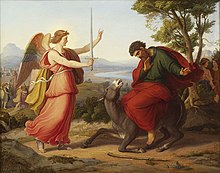Purismo
Purismowas an Italian cultural movement which began in the 1820s. The group intended to restore and preserve language through the study of medieval authors, and such study extended to thevisual arts.
Inspired by theNazarenesfrom Germany, the artists of Purismo rejectNeoclassicismand emulated the works ofRaphael,GiottoandFra Angelico.The movement flourished through 1860, and reflected the taste for revivalist styles, which in Italy was fed by growing interest in Italian national identity and artistic heritage.
History
[edit]
The term "Purismo" was coined in 1838 to describe the paintings ofAntonio Bianchinithat referred to the "primitive" Italian artists, fromCimabueto the firstRaphael.This nostalgia paralleled changes in literary taste, which was looking back to Tuscan 14th century poetry and literature. In that way, Purismo was similar to thePre-Raphaelitemovement in Great Britain.
The group's ideals were declared in their manifestoDel purismo nelle arti,in 1842–43 which was written by Antonio Bianchini and co-signed by major proponent of PurismoTommaso Minardi(1787–1871), Nazarene co-founderFriedrich Overbeck,and sculptorPietro Tenerani.
Another important support of Purismo wasLuigi Mussini,called from Paris as the director of the Regio Istituto Senese di Belle Arti. In 1841, he combined references to the Umbrian paintings of the 15th century with influences from the Nazarenes andIngresin his paintingLa Musica Sacra(stored in Florence'sGallery of Modern Art). Tommaso Minardi's pupils Antonio Ciseri and Costantino Brumidi and Mussini's pupilsAlessandro Franchi,Amos CassioliandCesare Maccariare all linked to the movement, as well asBartolomeo Pinelli,Giambattistia Gigola, andGiovanni De Min.
Maurizio Dufou was the main Purismo proponent in Liguria; he was joined by artists such asLuigia Mussini Piaggio.In Genoa, the largest realization of the movement's style is theBasilica di Santa Maria Immacolata.
With the first national Italian exhibition in 1861, which took place in Florence, the fortunes of Purismo began to decline and be replaced by the styles ofVerismoand theMacchiaioli.
References
[edit]
